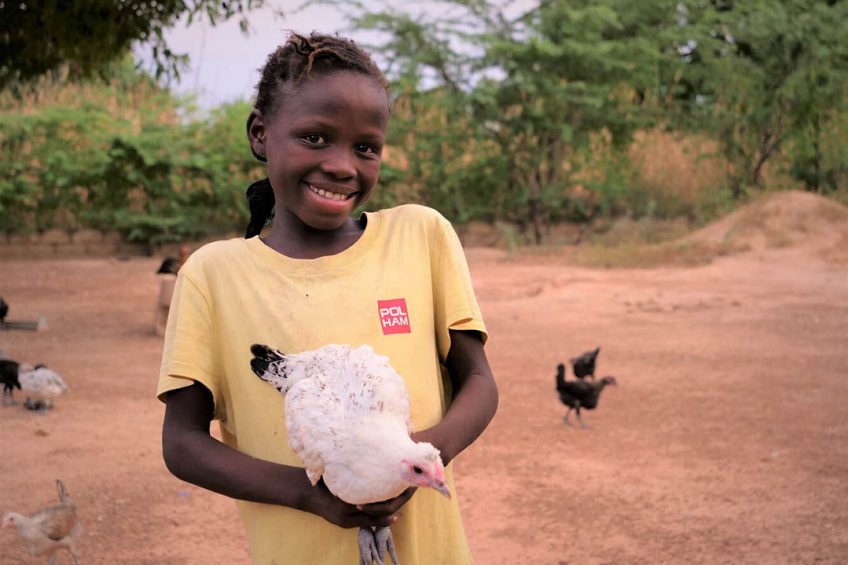Crossbreed chicken increases production 100-fold

A project in Burkina Faso has allowed approximately 1,000 small-scale chicken farmers to increase their productivity 100-fold.
The project, which has been 5 years in the making by animal health company Ceva, set out to produce a cross-breed of local chickens and slow-growth French Sasso hens, known as Poulet du Faso, with greater production capacity to provide smallholders with more and healthier day-old chicks. The chicks are all vaccinated in the hatchery using Ceva’s vectorised vaccines, which, according to the company, gives them life-long protection against Newcastle Disease, which is very prevalent in Africa. Mortality rate among Poulet du Faso is just 5% compared to 50% among traditional breeds. Furthermore, the crossbreed reaches market weight (1.2 to 1.4kg) in 75 to 90 days compared to the typical 6 months’ rearing required for its local counterpart.
The first avian selection centre in sub-Saharan Africa
Ceva partnered with Sasso-Hendrix Genetics to breed the chickens at the first avian selection centre in sub-Saharan Africa, Coq du Faso, which opened in 2016 in the rural Boussé, 50km north of the capital city. According to Pierre-Marie Borne, the programme initiator and public affairs director for Africa and the Middle East at Ceva: “The avian selection process at the centre is focused on the pure local breed. The Coq du Faso selection centre was established to undertake selection work in order to preserve and, in parallel, improve the local Burkina poultry breed referred to as the “Poulet Bicyclette,” or Bicycle Chicken.
“After 4 years of carefully measuring and analysing different parameters as part of 5 selection rounds, the 5th generation of pedigrees now have double the laying capacity of their local counterparts. The approach has enabled the local adaptability and rusticity of the Poulet Bicyclette to be preserved whilst improving its productivity. And more importantly, the phenotype, or the way the birds look, the “poulet grillé”, or grilled chicken, has remained unchanged, much to the delight of the Burkinabé who are very attached to their local breed.”
Characteristics of Poulet Bicyclette
The local breed is favoured in Burkina Faso mainly for their taste. “The meat is darker and more flavoursome; the Burkinabé loathe the taste of the ‘bland’ white standard broiler meat,” says Borne, adding that in terms of phenotype, “they have very long legs and so run very fast. Obviously, their performance in terms of productivity is not their best feature, but they are rustic and therefore more resistant to the Burkinabé context and climatic conditions than other genetics.”
 USGC promotes poultry industry growth in West Africa
USGC promotes poultry industry growth in West Africa
Producers are battling to meet an ever-increasing demand for poultry meat and eggs in sub-Saharan Africa.
US$ 3 million income
Overall, each Poulet du Faso generates US$ 2 across the different elements of the value chain, meaning that since the start of production just 2.5 years ago, the project has generated approximately US$ 3 million in income, 70% of which has directly benefited smallholder farmers.
Enormous potential
“The current yearly Poulet du Faso production in Burkina is around 1.3 million day-old chicks, which is far below the huge demand for this product. There is enormous potential to scale up this system to improve rural livelihoods and contribute to greater food security in Burkina Faso,” says Borne. The project has partnered with a local private hatchery to produce the crossbreed day-old chicks, starting with the main one based in the south of Ouagadougou. Production has been extended with another private hatchery located in Bobo-Dioulasso (south west region), and, thanks to the demand from local farmers, production will soon be produced in a 3rd private hatchery.
Burkina Faso’s poultry industry at a glance
- Potential demand for poultry meat: 58,455 tonnes
- Current supply: 25,031 tonnes
- Broiler production per year: 31,288,273 broilers (2015)
- Egg production per year: 109,788,433 eggs (2015)
- National flock size: 700,000 layers and 600,000 broilers exotic genetic per year.
- The remainder is produced in small-scale commercial farms and (backyard) traditional rural systems using the non-selected local breed.
- Except for eggs, the avian production remains in the hands of small commercial farms and traditional farmers.












